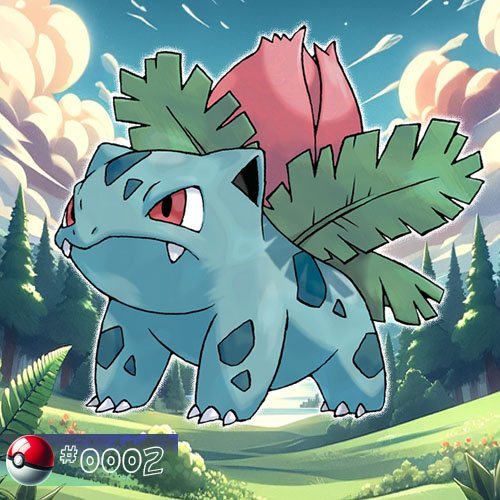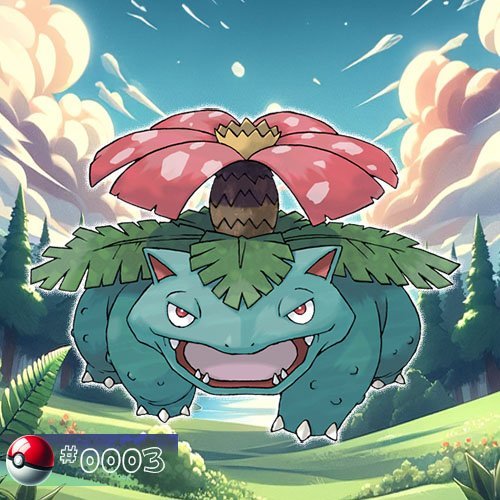Ivysaur
Biology
Physical Characteristics
Ivysaur is the second stage in the evolutionary line that begins with Bulbasaur and culminates in Venusaur. Its design reflects a transitional phase, with features that bridge the gap between the juvenile Bulbasaur and the fully evolved Venusaur.
Ivysaur’s eyes maintain the red coloration with white pupils, a feature carried over from Bulbasaur. The eyes contribute to its determined and focused expression. He has a rounded snout and a small mouth, maintaining a level of cuteness while showcasing signs of maturity.
The plant bulb on Ivysaur’s back continues to evolve from the smaller version seen in Bulbasaur. It becomes more prominent, showcasing intricate patterns and additional layers. The bulb is a focal point of Ivysaur’s design, representing its status as a Grass/Poison-type Pokémon.
To accommodate the growing weight of the plant bulb, Ivysaur’s legs and trunk become thicker and sturdier. This adaptation ensures that Ivysaur maintains balance and stability, supporting its quadrupedal stance.
Ivysaur, like its pre-evolution, can absorb sunlight through the bulb on its back. This process is not only essential for its own energy but also contributes to the overall growth of the plant. The relationship between Ivysaur and sunlight showcases its reliance on environmental factors.
Ivysaur retains the Grass/Poison typing inherited from Bulbasaur. This dual typing not only influences its appearance but also defines its strengths and weaknesses in battles.
In certain game versions, Ivysaur may possess the hidden ability Chlorophyll. This ability enhances its speed in sunny weather, showcasing a biological adaptation to environmental conditions.
Behaviour
As the evolved form of Bulbasaur, Ivysaur exhibits a more mature demeanor while retaining elements of its pre-evolution’s docile nature. It may showcase increased confidence and a sense of responsibility. Ivysaur is known to be cautious and observant of its surroundings. Its heightened awareness helps it navigate different environments effectively and anticipate potential threats.
Ivysaur strikes a balance between the playful innocence of Bulbasaur and the more stoic nature of its final evolution, Venusaur. This balanced nature contributes to its versatility as a Pokémon.
In various Pokémon media, Ivysaur has been depicted as possessing natural leadership qualities. This may include taking charge during group activities or offering guidance to other Pokémon.
Like Bulbasaur, he is known for its protective instincts. It may display a willingness to defend its trainer and fellow Pokémon from threats, showcasing loyalty and bravery.
Ivysaur may form strong, affectionate bonds with its trainer. Through shared experiences and battles, it deepens its connection with the one who cares for it. In its natural habitat, it may form bonds with other Ivysaur and Pokémon species, creating social structures within groups. Ivysaur communicates with other Pokémon and its trainer through various vocalizations, body language, and expressions. It may convey emotions and intentions through its distinctive sounds and behaviors.
Due to its quadrupedal stance and increased size, Ivysaur demonstrates adaptability in various terrains. It can navigate forests, grasslands, and other environments with ease, showcasing its ability to adjust to different surroundings.
Whether displaying leadership, protective instincts, or social behavior, Ivysaur contributes to the dynamic and diverse ecosystem of Pokémon behavior and relationships.
Evolution
Ivysaur’s evolutionary journey begins with its pre-evolution, Bulbasaur.
The primary trigger for Ivysaur’s evolution is reaching a specific level. In the case of Bulbasaur evolving into Ivysaur, this occurs at Level 16. When Bulbasaur reaches Level 16, it undergoes a significant transformation. This marks the transition from the initial stage of its development into the intermediate stage, Ivysaur.
The most noticeable change during evolution is the growth and development of the plant bulb on Bulbasaur’s back. This bulb, which starts as a small seed, becomes more pronounced and intricate in design.
Ivysaur, like Bulbasaur, as we already mentioned above, continues to absorb energy from sunlight through its plant bulb.
Ivysaur represents an intermediate stage in the evolutionary line that leads to the final form, Venusaur. This phase showcases the ongoing progression of Bulbasaur’s initial seed into a more mature and developed plant. Throughout its evolution, Ivysaur retains the Grass/Poison typing inherited from Bulbasaur.
While Ivysaur is a powerful and capable Pokémon, its evolution serves as preparation for the final stage of its development: Venusaur at level 32. This anticipation adds a sense of continuity to the evolutionary process, with Ivysaur representing a crucial step in the growth of Bulbasaur’s initial seed.
Appearances
Anime Main Appearances
Ivysaur made its initial appearance in the episode titled “Bulbasaur’s Mysterious Garden.” The narrative centers around Ash Ketchum and his companions, who stumble upon a hidden haven known as Bulbasaur’s Mysterious Garden. Within this haven, they encounter a community of Bulbasaur and Ivysaur, each living harmoniously amidst the vibrant flora.
May, one of Ash’s traveling companions in the Hoenn region, obtained a Bulbasaur during her journey. May became the owner of an Ivysaur after her Bulbasaur evolved. This evolution took place sometime after the events in “The Right Place and the Right Mime.” Furthermore, May’s Ivysaur continued to develop and eventually evolved into a Venusaur, achieving this transformation prior to the episode titled “Pruning a Passel of Pals!”
In a parallel storyline, Shauna, a Pokémon Trainer introduced in the Kalos region, known for her cheerful and positive personality, obtained an Ivysaur after her Bulbasaur underwent an evolution, an event that occurred offscreen. The evolution transpired before the events narrated in the episode titled “Tag Team Battle Inspiration!”.
Anime Minor Appearances
In the Pokémon anime episode “A Chansey Operation,” Ivysaur makes its debut appearance as one of the Pokémon brought to the clinic. The episode revolves around the dedicated efforts of Pokémon Center staff, including the nurturing Chansey, to provide care and healing to injured Pokémon.
In “The Ultimate Test,” Ivysaur makes a notable appearance as part of James’s team during the Pokémon League Admissions Exam. This episode is marked by unique challenges and tests that Trainers undergo to qualify for the prestigious Pokémon League.
In the Pokémon movie “The Power of One” Ivysaur makes an appearance as part of a collective response from various Pokémon to the disturbances caused by Lawrence III. This movie, also known as Pokémon: The Movie 2000, explores the legendary Pokémon Lugia and the disruption caused by the actions of the collector Lawrence III.
In the Pokémon movie “Destiny Deoxys” Ivysaur makes a brief appearance during the opening sequence. “Destiny Deoxys” is the seventh Pokémon movie, and it explores the encounter between Rayquaza and Deoxys in the city of LaRousse.
In the Pokémon anime episode titled “Weekend Warrior” Ivysaur makes an appearance in a flashback, belonging to a Trainer named Jeremy. This episode explores the relationships between Pokémon and their Trainers and provides a glimpse into Ivysaur’s past evolution.
In the Pokémon anime episode titled “I Choose You!” Ivysaur makes an appearance when Pikachu encounters a Trainer’s Ivysaur at a Pokémon Center. This episode is known for its retelling of the early adventures of Ash Ketchum and Pikachu in the Kanto region.
In the Pokémon anime episode “A Dream Encounter!” Ivysaur stars in a video advertisement for Aether Paradise, showcasing the Pokémon’s habitat within the research facility.
In the episode, ”This Could be the Start of Something Big!” Ash and his friends find themselves on the beautiful Valencia Island in the Orange Archipelago. During their adventures on the island, Ash’s Bulbasaur is exposed to a special ray of sunlight known as the Solar Beam, which is emitted only on Valencia Island. As a result of this unique exposure, Bulbasaur undergoes an unexpected and temporary evolution, becoming an Ivysaur.
Manga Appearances
Ivysaur has made various appearances in Pokémon manga series, with its role often tied to the adventures of Trainers and the specific storylines of each manga. Here are some general points about Ivysaur’s appearances:
Pokémon Adventures (Pokémon Special)
Red/Blue/Green Arc – In the Kanto arc, Ivysaur may appear as the evolved form of Bulbasaur, either caught by a main character or a significant Trainer. Ivysaur might participate in battles and showcase its evolving powers.
Gold/Silver/Crystal Arc – Depending on the arc, Trainers may have Ivysaur in their teams, reflecting the continuity of their journeys from the previous arc. Evolving Ivysaur into Venusaur could be a significant plot point.
Ruby/Sapphire Arc – Trainers in the Hoenn region might have Ivysaur as part of their teams. The manga explores the unique abilities of Ivysaur in battle.
Diamond/Pearl/Platinum Arc – Trainers in the Sinnoh region may showcase Ivysaur in contests or battles. The evolving nature of Pokémon is often emphasized, and Ivysaur’s evolution may be a key event.
Black/White Arc – Ivysaur could make appearances in the Unova region, again demonstrating the continuity of Trainers’ journeys.
Other Pokémon Manga
Movie Tie-Ins
Ivysaur may appear in Pokémon manga adaptations related to animated movies. For example, tie-ins to movies featuring Bulbasaur’s evolutionary line.
Special Chapters
Some Pokémon manga series include special chapters or one-shot stories that may feature Ivysaur in unique situations.
Game data
Stats
Location
| Game version | Location |
|---|---|
| Pokémon Red and Pokémon Blue | Evolve Bulbasaur |
| Pokémon Yellow | Evolve Bulbasaur |
| Pokémon Gold and Pokémon Silver | Evolve Bulbasaur |
| Pokémon Crystal | Time Capsule (trade) |
| Pokémon Ruby and Pokémon Sapphire | Trade |
| Pokémon FireRed and Pokémon LeafGreen | Evolve Bulbasaur |
| Pokémon Emerald | Trade |
| Pokémon Colosseum | Trade |
| Pokémon XD: Gale of Darkness | Trade |
| Pokémon Diamond and Pokémon Pearl | Trade |
| Pokémon Platinum | Trade |
| Pokémon HeartGold and Pokémon SoulSilver | Evolve Bulbasaur |
| Pokémon Black and Pokémon White | Poké Transfer |
| Pokémon Black 2 and Pokémon White 2 | Poké Transfer |
| Pokémon X and Pokémon Y | Evolve Bulbasaur, Friend Safari |
| Pokémon Omega Ruby and Pokémon Alpha Sapphire | Trade |
| Pokémon Sun and Pokémon Moon | Trade |
| Pokémon Ultra Sun Pokémon Ultra Moon | Evolve Bulbasaur |
| Pokémon: Let's Go, Pikachu! and Pokémon: Let's Go, Eevee! | Evolve Bulbasaur |
| Pokémon Sword and Pokémon Shield | Trade |
| Pokémon Brilliant Diamond and Pokémon Shining Pearl | Evolve Bulbasaur |
| Legends Arceus | Unobtainable |
| Pokémon Scarlet and Pokémon Violet | Evolve Bulbasaur |
Ivysaur's origin name
The name “Ivysaur” is a harmonious blend of two key elements, each contributing to the essence of this Pokémon.
English: The name “Ivysaur” is a combination of two key components: “ivy” and “dinosaur.”
The term “ivy” refers to a type of climbing or trailing plant that is known for its lush, green foliage. Ivy plants often have distinct, lobed leaves and are commonly associated with growth and vitality. The inclusion of “ivy” in Ivysaur’s name likely alludes to the plant bulb on its back, emphasizing its connection to nature and its Grass-type characteristics.
The second part of Ivysaur’s name, “dinosaur,” points to the creature’s reptilian and prehistoric characteristics. The use of “dinosaur” in Ivysaur’s name reflects its evolutionary link to Bulbasaur, a more reptilian-like Pokémon, and hints at the reptilian features still present in its design.
This name effectively captures the essence of Ivysaur as a transitional stage between the more plant-focused Bulbasaur and the fully evolved Venusaur.
Japanese: フシギソウ (Fushigisou) – The Japanese name is a combination of 不思議 (fushigi), meaning “mysterious” or “strange,” and 草 (sou), meaning “grass.” This name emphasizes the mysterious and grass-related aspects of Ivysaur.
German: Bisaknosp – The German name is derived from “Bisam” (muskrat) and “Knospe” (bud), emphasizing the plant bud on Ivysaur’s back.
French: Herbizarre – This French name is a combination of “herbe” (grass) and “bizarre” (strange or odd), reflecting its grass-type nature and mysterious appearance.
Spanish: Ivysaur – The Spanish name “Ivysaur” remains the same as the English name.
Italian: Ivysaur – The Italian name “Ivysaur” remains consistent with the English name.
Korean: 이상해풀 (Isanghaepul) – The Korean name combines 이상해 (isanghae), meaning “strange” or “odd,” with 풀 (pul), meaning “grass.”
Chinese (Simplified): 妙蛙草 (Miào Wā Cǎo) – This Chinese name consists of 妙 (miào), meaning “wonderful” or “strange,” 蛙 (wā), meaning “frog,” and 草 (cǎo), meaning “grass.”
Chinese (Traditional): 妙蛙草 (Miào Wā Cǎo) – The Traditional Chinese name is the same as the Simplified Chinese version, combining “wonderful,” “frog,” and “grass.”
These names showcase the linguistic diversity and creativity used in different regions to capture the essence of Ivysaur’s characteristics and attributes.





